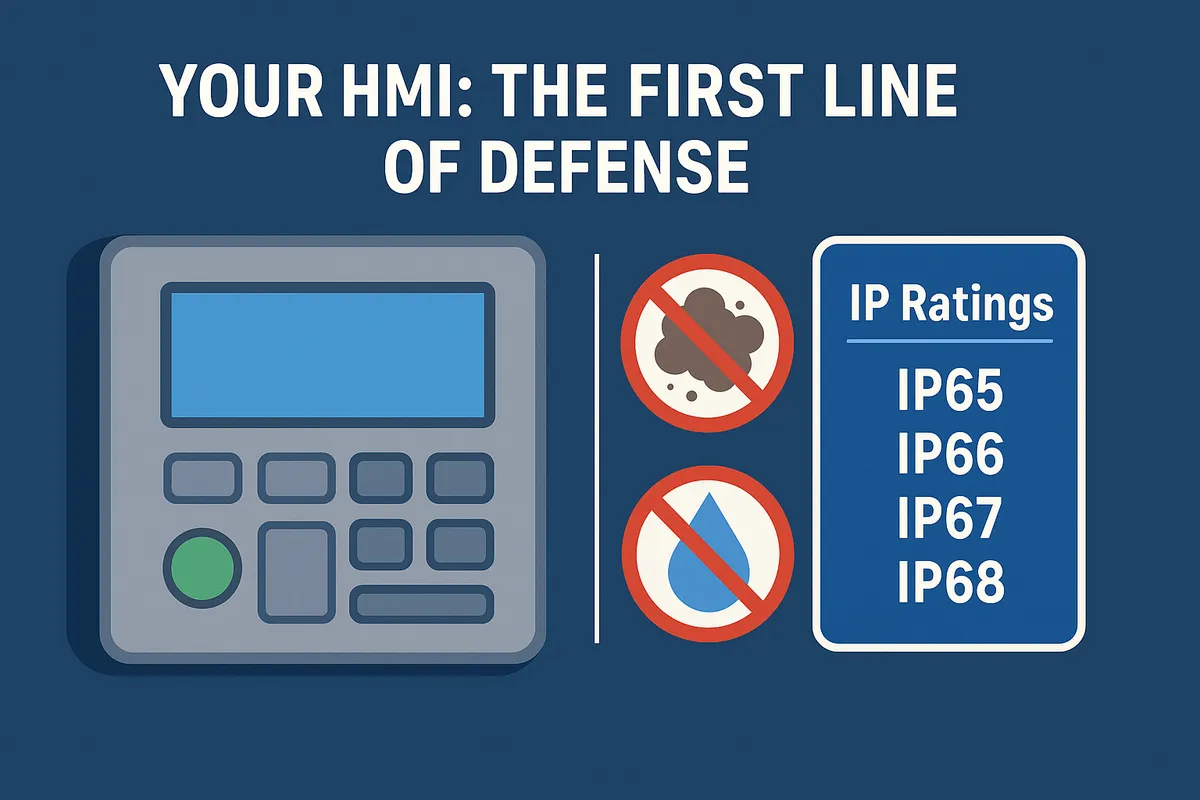A Guide to IP-Rated Membrane Switches for Harsh Environments
In industrial, medical, and outdoor applications, the Human-Machine Interface (HMI) is more than just a control panel—it's a critical barrier protecting sensitive internal electronics from the environment. A single drop of moisture or a particle of dust entering the device can lead to catastrophic failure, resulting in costly downtime and repairs.

Your HMI: The First Line of Defense
In industrial, medical, and outdoor applications, the Human-Machine Interface (HMI) is more than just a control panel—it’s a critical barrier protecting sensitive internal electronics from the environment. A single drop of moisture or a particle of dust entering the device can lead to catastrophic failure, resulting in costly downtime and repairs. This is why Ingress Protection (IP) ratings are a crucial specification for any durable product. Membrane switches, by their very nature, offer one of the most effective and cost-efficient ways to achieve a high level of ingress protection for your HMI.
Decoding IP Ratings: A Practical Guide
The IP rating system (IEC 60529) is an international standard that classifies the degree of protection an enclosure provides against the intrusion of solids and liquids. The rating is composed of two digits:
- First Digit (0-6): Protection against solid objects and dust.
- Second Digit (0-9): Protection against liquids.
| Rating | First Digit: Solids Protection | Second Digit: Liquids Protection |
|---|---|---|
| IP65 | 6: Dust Tight (No ingress of dust) | 5: Protected against low-pressure water jets from any direction. |
| IP66 | 6: Dust Tight (No ingress of dust) | 6: Protected against high-pressure water jets from any direction. |
| IP67 | 6: Dust Tight (No ingress of dust) | 7: Protected against immersion in water up to 1 meter for 30 minutes. |
| IP68 | 6: Dust Tight (No ingress of dust) | 8: Protected against long periods of immersion under pressure. |
For most demanding applications, a rating of IP65 or IP67 is the target. An IP65-rated HMI can be washed down, while an IP67-rated HMI can survive temporary submersion, making them ideal for everything from food processing equipment to marine electronics.
How Membrane Switch Construction Achieves High IP Ratings
A membrane switch isn’t just a collection of buttons; it’s a sealed system. Its ability to achieve high IP ratings comes from its unique layered construction.
1. 360-Degree Perimeter Sealing
The foundation of a waterproof HMI is the adhesive bond between the membrane switch and the product enclosure. Using a full-perimeter, high-performance adhesive (like those from 3M’s 300LSE series) creates a continuous gasket. This seal prevents any contaminants from getting past the edge of the panel. A supplier with expertise in custom die-cutting, like G&D Elektronik, ensures this gasket is perfectly shaped to your enclosure for a flawless seal.
2. Impermeable Graphic Overlays
The top layer of the switch, the graphic overlay, is typically made from polyester or polycarbonate. These materials are inherently waterproof. Because all graphics are printed on the reverse side of this layer, they are fully protected from abrasion and chemical wipe-downs. For medical applications, chemically resistant overlays can be specified to withstand harsh disinfectants.
3. Integrated, Sealed Connectors
The final potential point of failure is the flexible tail that connects the switch to the main PCB. This connection can be protected using sealed connector systems (e.g., ZIF/LIF) or by designing the panel so that the tail passes through a sealed slot in the enclosure, often compressed by a gasket.
Beyond IP: Chemical, UV, and Abrasion Resistance
For truly harsh environments, protection needs go beyond just dust and water. Material selection is key:
- Chemical Resistance: For medical devices or industrial controls exposed to solvents, polyester (PET) overlays offer superior resistance compared to polycarbonate (PC).
- UV Resistance: In outdoor applications, special UV-resistant hard coats and inks are necessary to prevent the graphic overlay from yellowing and cracking over time.
- Abrasion Resistance: Textured or hard-coated overlays can be specified to resist scratches and wear in high-use environments like public kiosks or factory floors.
By discussing the specific operating environment with your membrane switch supplier, you can specify a combination of materials and construction techniques to create a truly rugged HMI that will not fail in the field.
Frequently Asked Questions (FAQ)
What is the difference between an IP rating and a NEMA rating? IP ratings are an international standard focused on ingress protection. NEMA ratings are a US standard that also includes testing for corrosion resistance, gasket aging, and construction details, making them more comprehensive but less commonly used outside North America.
Does adding backlighting affect the IP rating? No. When properly designed, backlighting technologies like side-LED or fiber optic layers are fully integrated and sealed within the membrane switch’s layers, having no impact on its environmental seal.
Is an IP67 switch more expensive? Achieving an IP67 rating is primarily about proper design and material selection. The cost difference between a non-sealed and a fully sealed IP67 switch is often minimal, making the investment in durability one of the highest-value decisions you can make.
